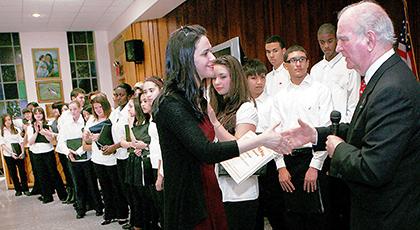By Jeremy Walsh
The memory of those lost nearly a century ago in a factory fire that changed the course of American industrialism was kindled once again in Middle Village last Thursday as the Triangle Fire Memorial and Historical Association held its annual ceremony.
Around 50 people attended the ceremony at Christ the King High School, which included performances by the school’s concert chorus and a reading of the names of all 146 victims of the Triangle Shirtwaist Factory in 1911.
Politicians and labor activists mobilized in the fire’s aftermath to almost completely revise work place safety regulations in New York state.
Former state Sen. Serphin Maltese, who organized the event, recalled fond memories of his grandfather, who lost his wife and two daughters in the fire and another daughter, Maria, 5, after she fell ill at Ellis Island following the trip from Italy.
“I think he exemplified the immigrants,” Maltese said. “When he earned enough as a shoemaker, he sent for his family. … They worked with their hands so that we, the sons and daughters, could become doctors and lawyers.”
Maltese said he and his family learned later that it took Serafino Maltese 10 months before he was able to identify his wife’s remains by a wedding ring that was recovered.
Serphin Maltese’s grandmother, Caterina, and his two aunts, Lucia and Rosarea, were buried in Calvary Cemetery in Maspeth, as were more than 40 other victims.
The victims of the fire were immigrant garment workers, almost exclusively female, many younger than 20. They were remembered for their industriousness by former City Councilman Anthony Como, a second-generation Italian American.
“My family grew up working in sweatshops and factories,” Como said. “If it were not for them, mark my words, I would not be here today.”
The fire began around 4:45 p.m. March 25, 1911. Some historians believe it was started by a worker flicking a lit cigarette into a wastebasket. The factory, which occupied the top three floors of the Asch Building in Greenwich Village, was a maze of flammable clothing scraps, lead-lined paper garment patterns and drums of oil to lubricate the sewing machinery.
It began to spread, trapping the girls who worked on the floor. Management had ordered the main doors locked so guards could check the workers’ bags for stolen garments and unionizing literature.
A foreman on the eighth floor called and warned the management on the tenth floor, but because using the device was so expensive, no one warned the women on the ninth floor. As the fire spread, the girls began to jump from the ledge in groups, plunging through the tarps held by firefighters. Some even crashed through the glass skylights embedded in the pavement.
Reach reporter Jeremy Walsh by e-mail at jewalsh@cnglocal.com or by phone at 718-260-4564.
































